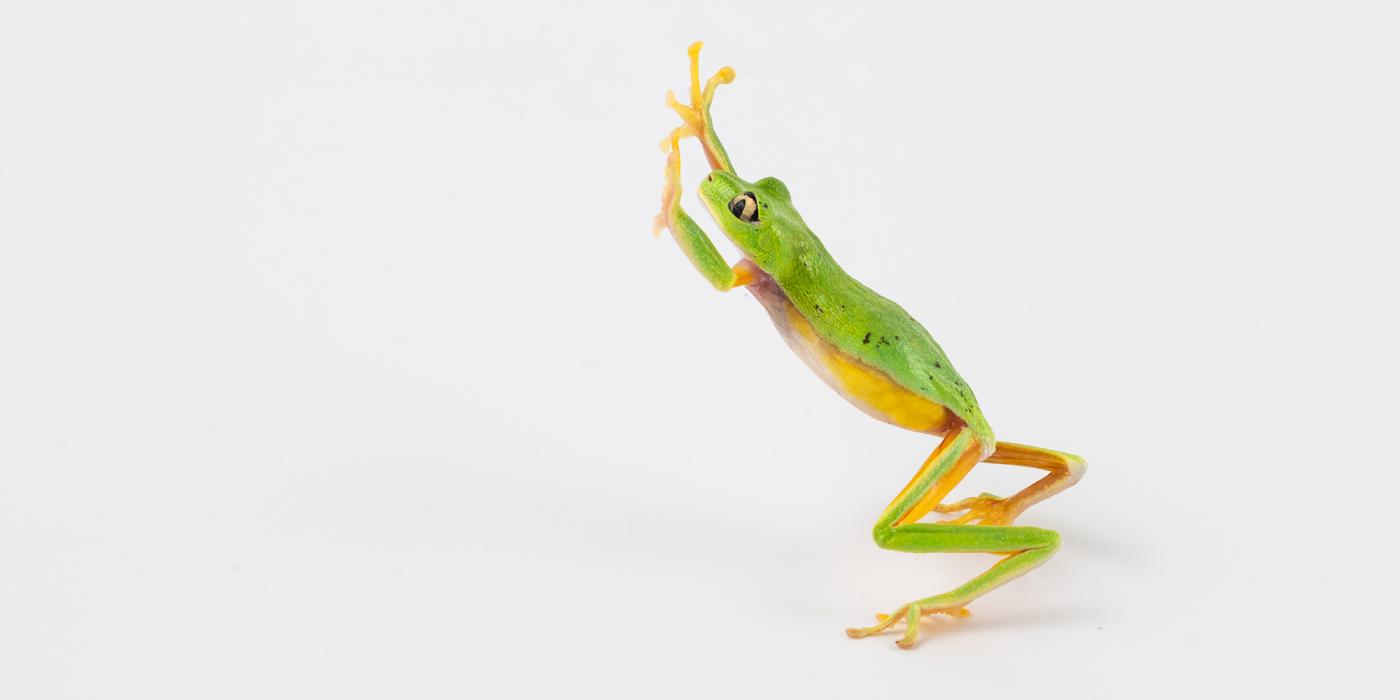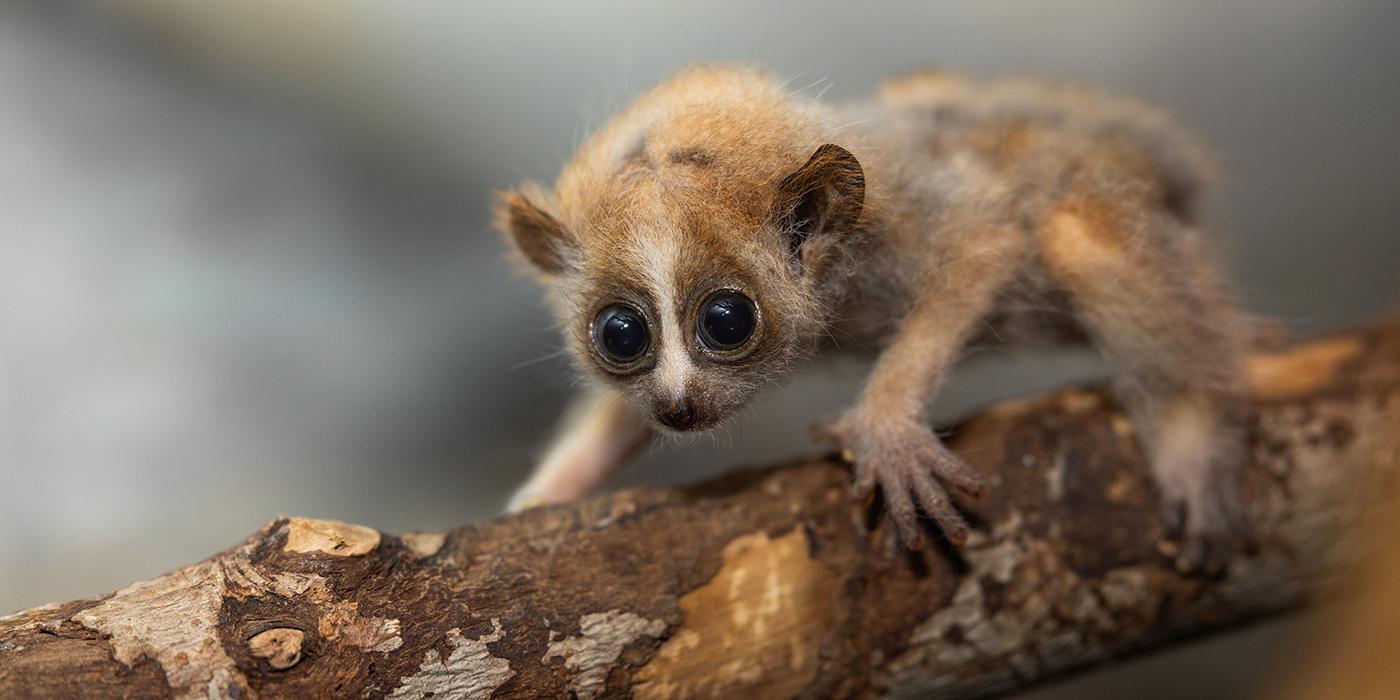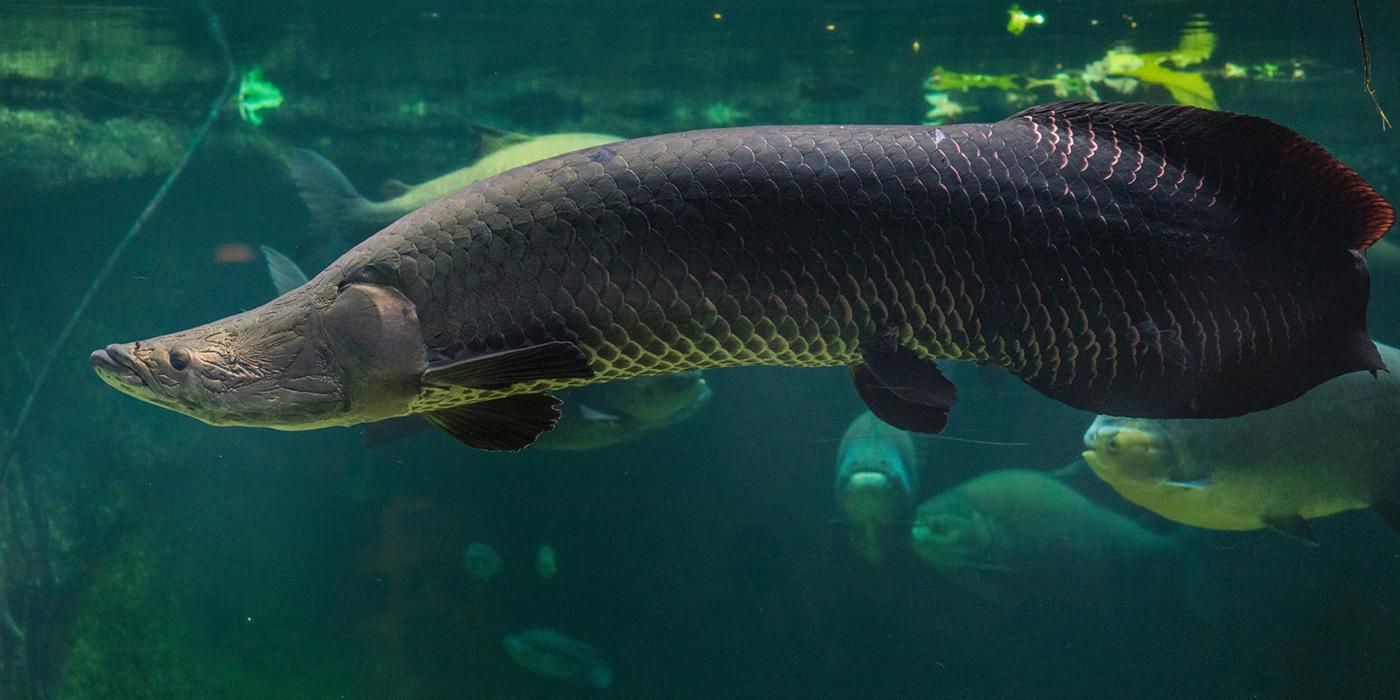Happy Amphibian Week 2024
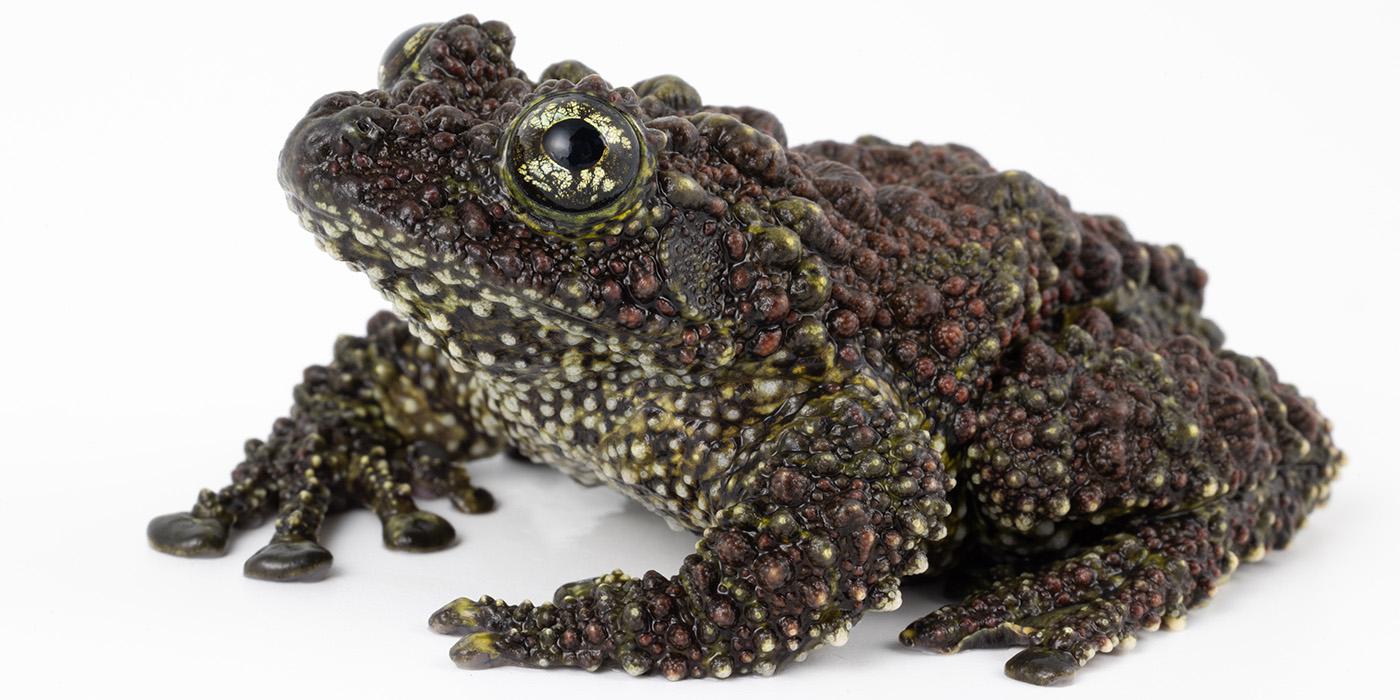
Have you ever strolled past an animal’s enclosure at the Zoo, thinking it was empty? Chances are, you were fooled by a creature whose camouflage allows it to seamlessly blend into its environment. Many of these “masters of disguise” are amphibians—animals that live part of their lives in the water, and part of their lives on land.
From frogs and toads to newts, salamanders and caecilians, amphibians have some of the most amazing adaptations and abilities in the animal kingdom. This Amphibian Week, take a closer look at what makes these species so wonderfully weird and worthy of our attention.
Join the celebration onsite and online! Don't miss Amphibian Day at the Reptile Discovery Center on May 5 from 10 a.m. to 2 p.m. And, tune into our Discovering Amphibians webinar May 8 at 2 p.m.
Frogs and Toads
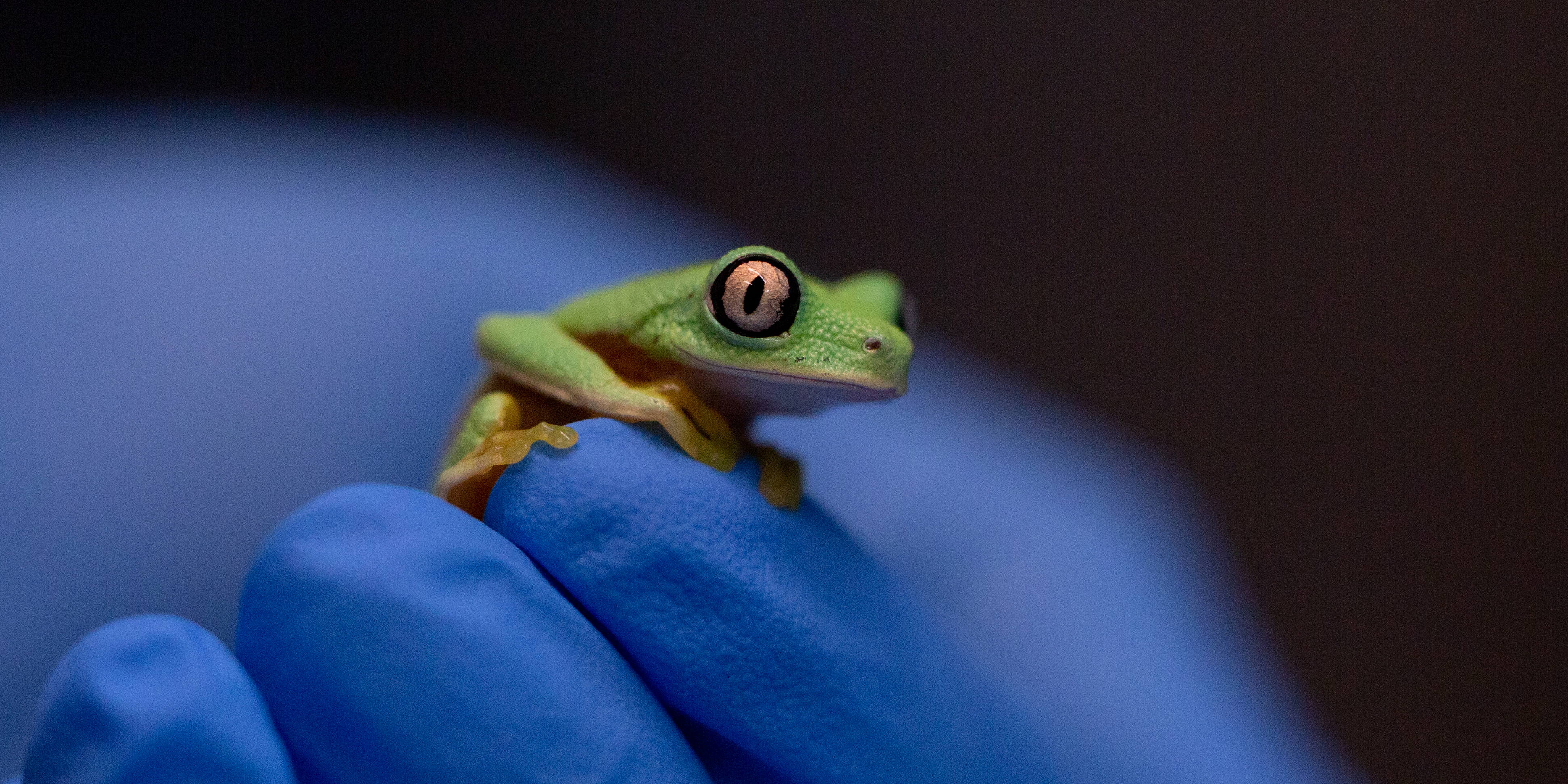
Lemur leaf frogs are nocturnal—they’re awake and active at night—so they have some amazing adaptations that set them apart from other frogs. Their large eyes have vertical pupils, enabling them to see well in the dark. Unlike other tree frogs, they do not jump to get from place to place, unless there is a predator and they need to dash away. Instead, they have very long, thin legs which they use for climbing and walking. When the sun comes up, they tuck themselves onto the underside of leaves. Their dorsal coloring—a vibrant green—blends in perfectly, camouflaging them while they sleep.
Keepers’ Advice for Spotting Lemur Leaf Frogs
During your next visit to the Reptile Discovery Center, be sure to stop by the lemur frog terrarium and take a close look under the leaves—they’ll be hiding there!
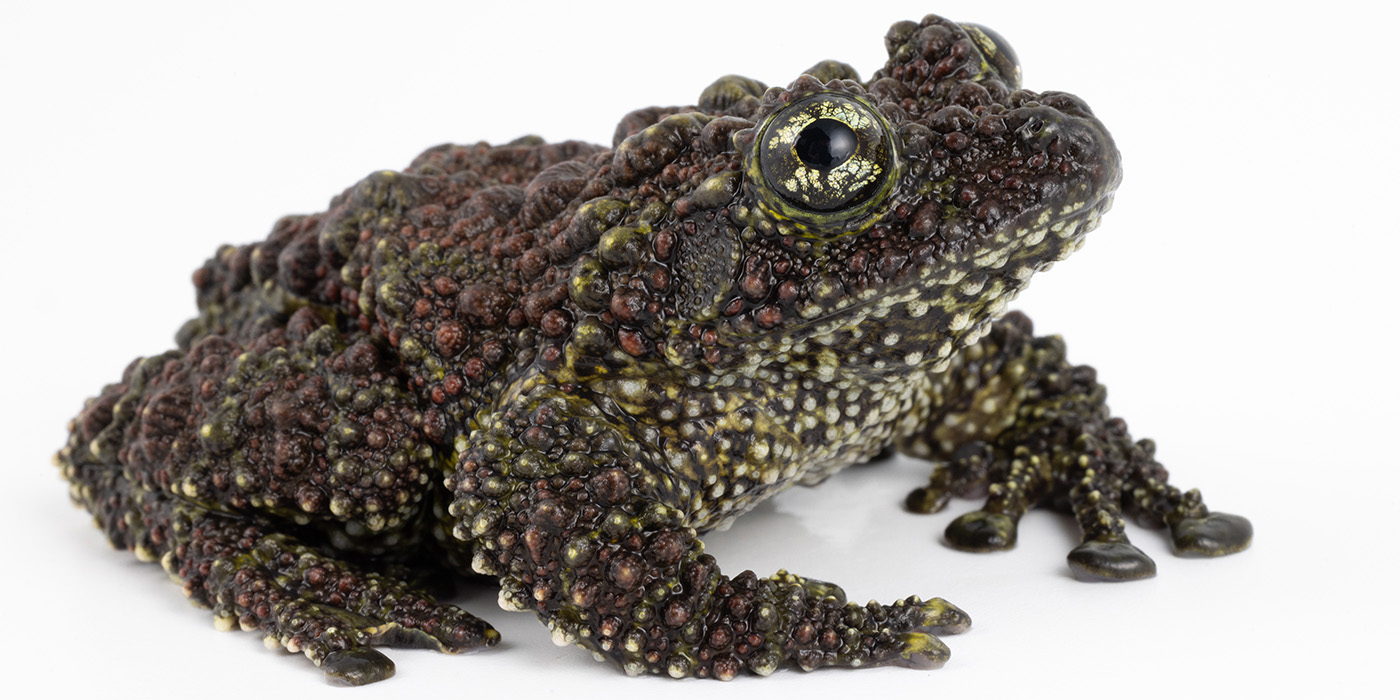
Meet the cutest clump of “moss” you ever did see: the Vietnamese mossy frog! They are truly masters of camouflage. Not only do their eye patterns blend in seamlessly with their skin patterns, looking at them from a distance, it’s very difficult to distinguish them from a clump of moss. Their defense mechanism is very unique, too. When they are nervous or frightened, they will curl up into a ball and plop into the water below to escape from harm’s way.
About two weeks after a mother mossy frog lays her eggs, the tadpoles hatch out. Initially, they are very dark in color. As they sprout limbs and grow into froglets, however, they start to develop their color. When they emerge from the water as fully formed froglets—around 3 months of age—they look like miniature versions of the adults, but bright red and green. As they age, these colors dull, and the red changes to maroon and brown, perfectly mimicking moss!
Keepers’ Advice for Spotting Mossy Frogs
Mossy frogs hide in plain sight and gravitate toward areas where they blend into the environment. They tend to be most active right when we open and close the Reptile Discovery Center. One of our exhibit frog’s favorite hangout spots is on the back wall of the exhibit, which is covered in faux rockwork. You have to look very closely to distinguish the frog from its habitat! I always enjoy watching visitors’ faces light up when they finally spot it.
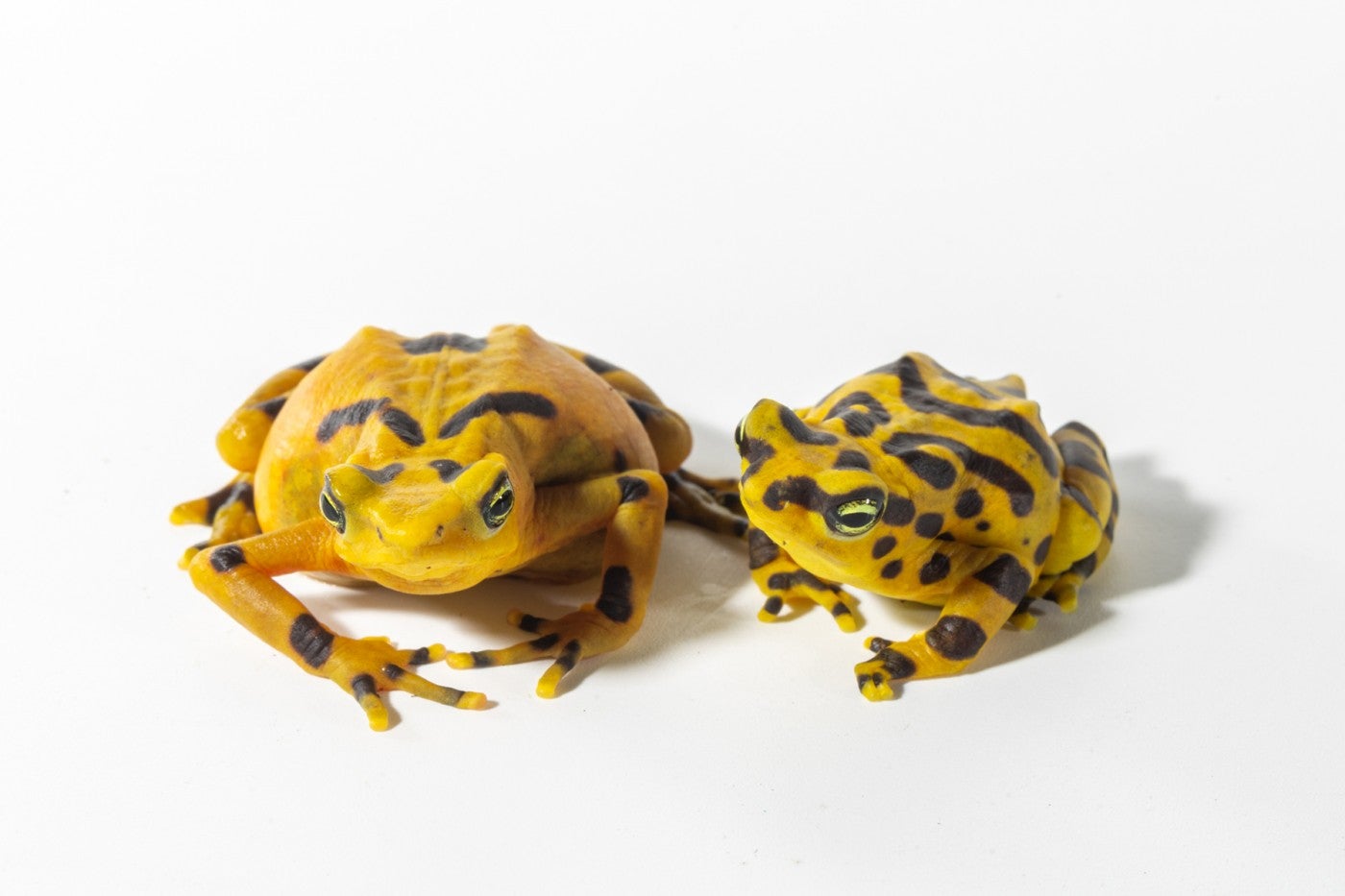
Panamanian golden frogs are actually toads, not frogs! In the 1980s and 90s, there was a beautiful toad called the golden toad in Montverde, Costa Rica. When that toad started to disappear suddenly from its habitat due to an emerging disease, it became widely recognized around the globe. They couldn’t call the Panamanian golden frog the golden toad—it would be confusing! So, they called it ‘frog,’ and the name just stuck.
We associate a lot of characteristics with toads, such as warty and bumpy skin. That’s not always the case. Panamanian golden frogs have very smooth skin, similar to dart frogs. They also have an upturned snout that gives them a rather distinguished look about them.
Keepers’ Advice for Spotting Panamanian Golden Frogs
These animals are active during the day. Visitors are likely to see them hopping around or resting on logs and bromeliads or underneath fronds. Even though they’re bright yellow and black, that pattern really helps them blend into the shadows when they want to!
At the Reptile Discovery Center, we feed them in the late morning on Mondays, Wednesdays and Fridays, and they’re quite active when they hunt. Or, you can make the Reptile Discovery Center your last stop at the Zoo. As soon as the sun starts to set, they climb up the plants and fall asleep on top of the leaves.
Salamanders and Newts
When scientists are trying to conserve a species, it's critical for them to know how many of those animals are living in the world. But when you're considering creatures like red-backed salamanders — which spend a lot of time underground — how would you try to count them?
It turns out, you need tiny "tattoos" and a lot of hands.
By counting the ratio of marked to unmarked salamanders in a designated plot, researchers can determine how many salamanders are in an entire forest! The Smithsonian is part of the Salamander Population & Adaptation Research Collaboration Network (SPARCnet), a group of scientists and educators that studies how different salamander populations are faring across North America. Together, SPARCnet monitors how climate change and land use may impact salamanders.
Japanese giant salamanders are the second-largest salamander species in the world. They can get up to 5 feet long and weigh 55 pounds. Japanese giant salamanders are very long and flat, and they have folds in their skin that create a lot of surface area for that respiration to occur. Oxygen goes in through their skin and carbon dioxide goes out. People think of amphibians as delicate, but Japanese giant salamanders are very tough and resilient. They can even lose limbs and recover just fine, even though their limbs won’t grow back.
Keepers’ Advice for Spotting Japanese Giant Salamanders
We have four Japanese giant salamanders at the Reptile Discovery Center – two females and two males – that were gifted to us from Asa Zoo in Japan in 2009. They are about 2 feet long, and our biggest male weighs about 6 kilograms (13 pounds). He was named Hiro by the Japanese Ambassador to the U.S. in 2010. We refer to the other three by their physical characteristics: Orange Male, Full-tail Female and Notch-tail Female.
Orange Male lives on exhibit right now, while the others live in the breeding area behind the scenes. They are all about 20 years old, but Japanese giant salamanders have been recorded living over 50 years in human care.
Many salamanders are ambush predators. The bigger, bulkier species tend to lunge at prey. Smaller species—including long-tailed salamanders and cave salamanders—have a different strategy. With prey in its sights, a salamander quickly contracts its muscles, causing the hyoid bone in its mouth to protrude. In the blink of an eye, the salamander’s elongated, sticky tongue has secured its meal. The northern red salamander can extend and withdraw its tongue in just 11 milliseconds!
Most salamanders have the ability to regenerate body parts—including limbs, tails, eye tissue and even brain tissue. By studying how the salamanders’ macrophages are able to repair and regenerate so effectively, scientists can take what they learn and apply it to human medicine. In future, what we learn could help those who have lost limbs or are battling Alzheimer’s disease.
Keepers’ Advice for Spotting “Jewels of Appalachia” Salamanders
Because salamanders are nocturnal, the best time to see them up and about at the Reptile Discovery Center is early in the morning and around dusk. Generally-speaking, our salamanders tend to hide in the dark crevices of their exhibit. Be patient, and look closely at areas that are mossy and damp—those are the salamanders’ favorite spots.
Although eastern newts are aquatic as larvae and adults, juveniles (called red efts) live on land! Around 2 to 5 months of age, their lungs, legs and eyelids make them more suited to life on land. As they search for water, they make their homes in leaf litter along the way.
Keepers’ Advice for Spotting Eastern Newts
Head to Amazonia’s Amphibian Alert exhibit to meet the eastern newts and see them up close.
What’s in a name? The emperor newt’s moniker comes from the Mandarin words "shan" (mountain) and "jing" (spirit or demon). This highly toxic amphibian lives only in the mountains along a handful of rivers in western China. During the breeding season, they live in water fields, like rice paddies, ponds or humid grasslands.
Keepers’ Advice for Spotting Emperor Newts
The emperor newts’ exhibit is near the exit of the Reptile Discovery Center, across from the Aldabra tortoises’ indoor habitat.
Caecilians
With a sleek, eel-like body and beady eyes, the aquatic caecilian is quite an unusual amphibian. They look like a cross between a snake and an eel, but they are neither. Just like frogs and salamanders, caecilians are amphibians. They are native to the Amazon River Basin in South America and spend their entire lives in the water.
There are some key differences between caecilians and other species of amphibians. Many amphibians can exchange oxygen through their skin via a specialized membrane, but caecilians do not. Their skin is quite thick, and they must come to the surface to take breaths of air. Juveniles take breaths more frequently, about every five to 10 minutes. Adults, however, can hold their breath between 20 to 30 minutes at a time.
Keepers’ Advice for Spotting Caecilians
Caecilians spend a lot of time exploring their habitat in Amazonia’s Amphibian Alert exhibit. Since we feed them at least four times a week, the odds are that visitors will be able to see them hunt. They are most active before lunch and during their afternoon feeding, which takes place around 2 p.m.
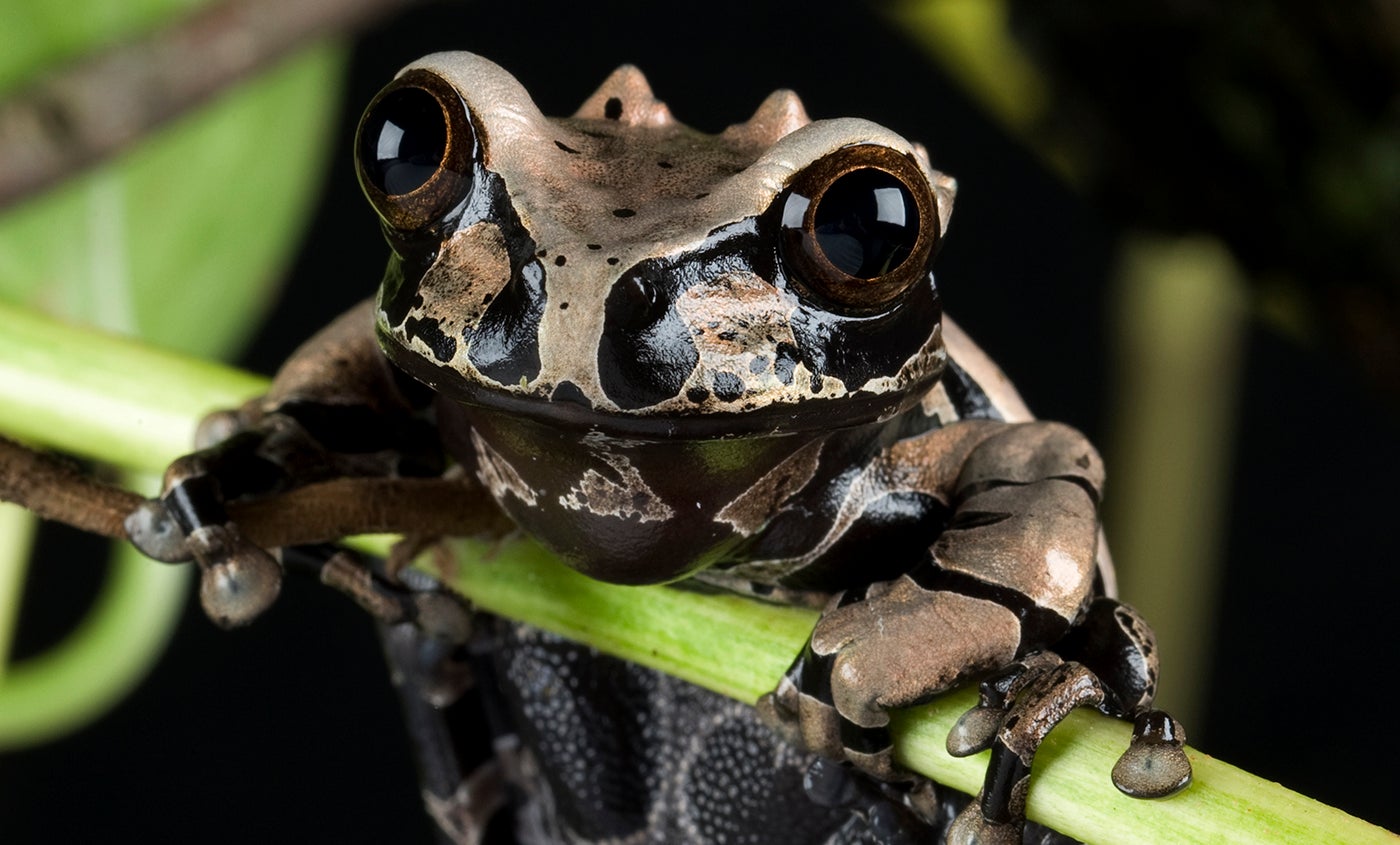
Hop To It: Help Amphibians
Saving amphibians takes a dedicated animal care team, cutting-edge conservation research and people like YOU! Get tips on how to help frogs, toads, salamanders, newts and caecilians from our experts.
- Keep habitats clean. Protecting amphibians means protecting water—especially the creeks, streams and temporary wetlands in our own neighborhoods and backyards. Amphibians thrive in areas where the water is pristine. When you fertilize your lawn in the spring and summer, or use ice melt on your sidewalks and driveway in the winter, not all of those chemicals get absorbed into the ground. A good portion of them runoff into the very wetlands where amphibians live, which negatively affects the quality of the water. Keep amphibians in mind as your make choices about your home and lawn care.
- Support conservation efforts. Accredited zoos are working to better understand amphibian biology, reproduction, disease and ecology. This conservation work is critical to their survival. Consider supporting these efforts by making a donation.
- Know Before You Buy. Many people love amphibians and want to keep them as pets. Remember that owning a pet is a commitment for the lifetime of that animal! Amphibians require specific (and sometimes costly) environmental, dietary and enrichment needs in order to thrive under human care. If you are able to provide these, only purchase pets from reputable organizations. Never buy an animal that was taken from the wild.
- Volunteer. Classroom education is important, but so is hands-on experience. If you want to work with amphibians, try your hand at an internship or volunteer at your local zoo. Our knowledge about these animals is constantly expanding, so being a life-long student will come in handy on this career path.
- Take a hike (safely). Before entering a stream, cave or other wild habitat, disinfect your footwear to avoid tracking bacteria and fungi that could be harmful to amphibians.
- Get involved in community science. Catalogue the wildlife you see and record that information for scientists studying them in the wild.
- Share their stories. Help others appreciate these animals and understand their value to our world.

